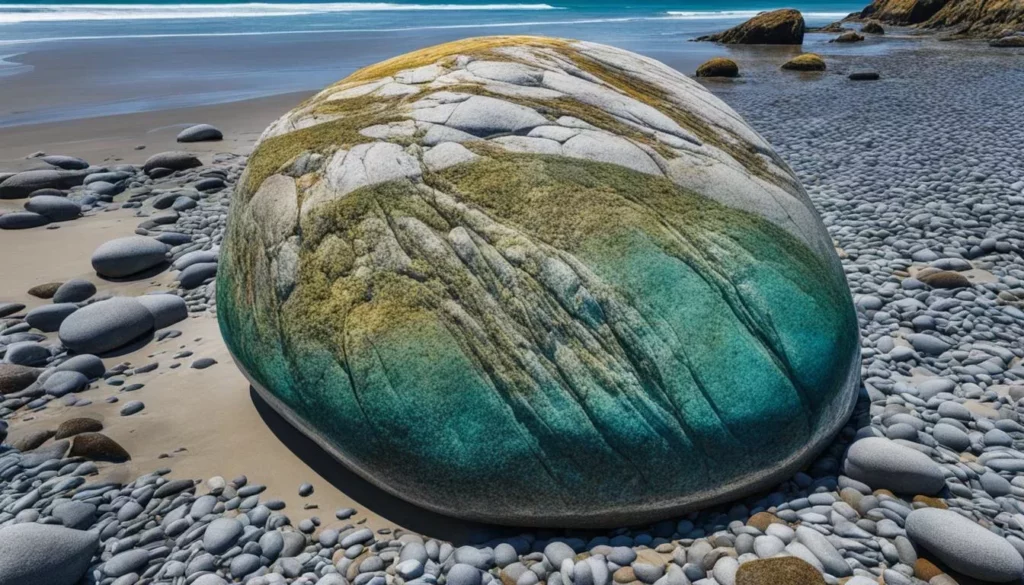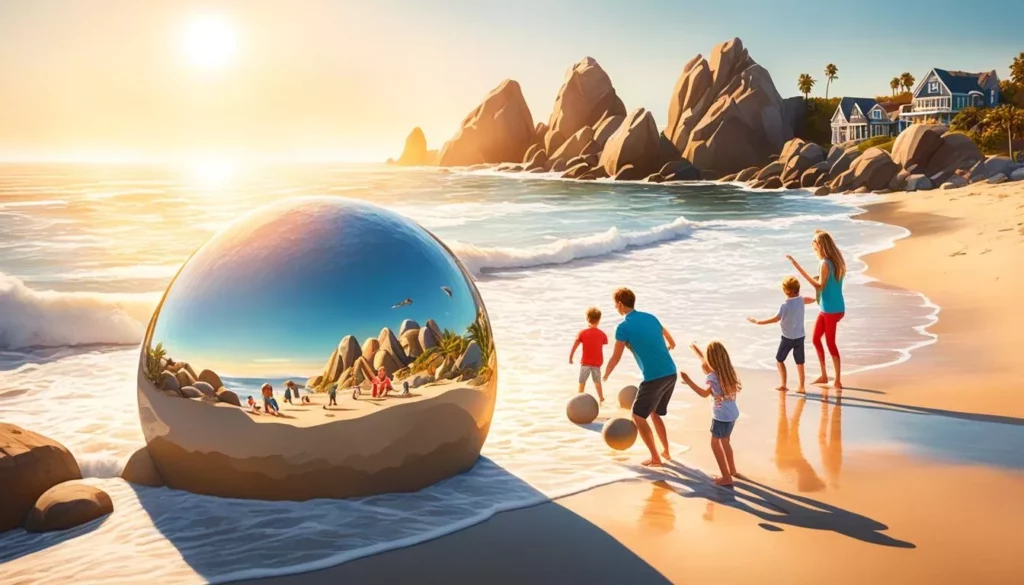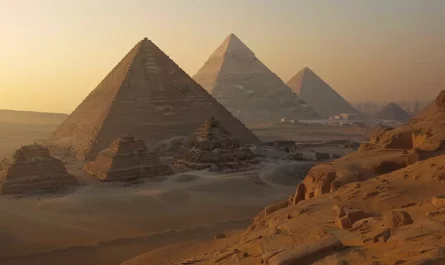Have you ever seen the giant Moeraki Boulders on Moeraki Beach? They can be really heavy, some weighing several tons. Some even stand as tall as six feet. Found on the beautiful Otago Coast of New Zealand, these boulders amaze both scientists and tourists.
The Moeraki Boulders look like big, almost perfect spheres on Koekohe Beach. Scientists say these giant rocks, made of calcite concretions, formed about 65 million years ago. Because of their size and unique look, they’re a top attraction on the Otago Coast. They’re something everyone must see when visiting New Zealand’s natural sights.
A Māori legend provides a different story about the boulders. They’re thought to be leftovers from eel baskets and other items. These came from the Araiteuru canoe, which legend says shipwrecked on New Zealand’s coast.
These mysterious rocks keep grabbing attention and fuel people’s imagination. Protecting them is very important. There are laws in place to make sure the Moeraki Boulders stay safe. This way, future generations can also enjoy and learn from these impressive natural formations.
The Enigmatic Nature of the Moeraki Boulders
The Moeraki Rocks are a wonder to see on New Zealand’s East Coast. They are huge and round, which is fascinating. Their unknown origins and the stories about them add to their mystery.
https://www.youtube.com/watch?v=2oaomacNeO8
Overview of the Moeraki Boulders
You can find the big, round Moeraki Boulders at Koekohe Beach. Some are as big as two meters across and weigh tons. Their smooth look makes them a must-see for anyone, including scientists and tourists.
Location and Accessibility
These boulders are on Koekohe Beach, between Moeraki and Hampden. You can get there via State Highway 1, from either Oamaru or Dunedin. The trip to these stunning rocks is beautiful and easy for all.
Tourist Attraction Status
The Moeraki Boulders are famous all over the globe. They stand for New Zealand’s natural beauty on the East Coast. People visit them all year, and efforts are made to keep them safe for others in the future.
The Geological Phenomenon Behind the Boulders
In New Zealand, the Moeraki Boulders are a stunning sight. They stand on Koekohe Beach as reminders of the earth’s past. Scientists and tourists find them fascinating.

Formation Process
These boulders began forming over 56 million years ago. Back then, marine mud turned into mudstone at the sea’s bottom. The process called concretion made this happen, with minerals like calcite joining the grains of sediment.
Over time, this process created their round shapes. Erosion then revealed these hard concretions. Now, they awe us on the beach.
Age and Composition
The Moeraki Boulders are quite old, from the Paleocene era. They’re made of minerals like magnesium and iron. They also contain oxygen and carbon isotopes. This tells us how special they are.
People love seeing their round shapes and huge size. These boulders are more than just pretty. They teach us about the earth’s geology.
Māori Legends and Cultural Significance
The Moeraki Boulders are very special to the Māori people of New Zealand. They represent parts of the Araiteuru canoe legend. Items from the canoe, like calabashes and eel baskets, turned into the stone spheres on the beach. This legend makes the boulders a crucial part of New Zealand’s myths and folklore.
The Legend of the Araiteuru Canoe
The Araiteuru canoe journeyed from Hawaiki, the Māori’s ancestral home. It met disaster off New Zealand’s coast. The boulders are seen as leftovers from the canoe, like eel baskets. This legend connects the boulders to the Māori’s cultural past.
Symbolism in Māori Culture
The boulders are symbols in Māori culture. Named “eel pots” and “alien’s brains”, they’re historical icons. They’re part of Māori sites across New Zealand. Like a Stonehenge, they link to history and enrich the culture.
| Aspect | Cultural Significance |
|---|---|
| Legend | Araiteuru canoe remains |
| Symbolism | “Eel pots”, “alien’s brains” |
| Sites | Māori cultural sites |
Saving these boulders is vital. They’re not just rocks but key cultural elements. By protecting them, we keep the Māori legend alive for others to see and learn.
A Visit to Moeraki Beach
A trip to Moeraki Beach is unforgettable along the Otago Coast. Its unique scenery and the famous Moeraki Boulders make it a must-see. Anyone traveling to New Zealand should stop here.

Best Times to Visit
Visit during low tide to get the best experience. At low tide, you can fully appreciate the boulders.
This time also offers perfect chances for photos and exploring. The beauty of the Otago Coast shines brightest then, making it a prime time for visitors.
Activities and Attractions
Beyond the boulders, the beach has more to offer. There are guided tours that explore the area’s history and Maori legends.
Wildlife spotting and beachcombing are also fun activities here. Koekohe Beach is a top spot for those who love untouched beauty and local eco-efforts.
Photography Tips for Capturing the Boulders
Taking photos of the Moeraki Boulders combines art with nature’s beauty. Aim to shoot during the golden hour for soft, warm light. This moment is perfect for capturing natural wonders against an amazing scene.
Try different angles and setups to show each boulder’s unique traits. Shifting your view reveals the boulders’ hidden aspects. Notice how the tide changes the beach, bringing life to your photos.
For a creative touch, use long exposures. This captures the sea’s movement around the boulders, making your photos more dramatic. Apply these New Zealand photography tips for stunning shots.
Also, it’s vital to respect the conservation work at Moeraki Beach. This helps preserve the area’s beauty for others to see. By following these rules, photographers aid in protecting this special place.
Scientific Explanations for the Spherical Shapes
Exploring the Moeraki Boulders, we discover the science behind their shape. These spherical rocks intrigue geologists. Various natural processes have shaped them.
Erosion and Weathering Effects
Erosion processes have played a big role over millions of years. The mudstone around the boulders wore away slowly. This revealed the hard, spherical rocks we see today.
These boulders have faced many natural elements. These interactions helped create their unique, spherical shape.
Concretion Process Detailed
The calcite concretions process is another key factor. Minerals like calcite, dolomite, and quartz, cement sediment grains inside the boulders. This process, taking millions of years, results in spherical shapes.
Geology insights show septarian cracks filled with yellow and brown calcite. These cracks tell us about ancient groundwater flow. They add to the boulders’ story.
Knowing the natural history of these spherical rock formations aids their preservation. Recognizing the importance of erosion processes and concretion is vital. It fuels efforts to protect these geological wonders for future study and enjoyment.
Conservation Efforts and Legal Protection
The Conservation of natural sites is essential. It helps keep unique places like the Moeraki Boulders safe for everyone in the future. The boulders, a vital part of New Zealand’s nature, are now protected by law. This prevents their damage or removal. Before this law, many smaller boulders were taken from the beach.
Efforts to preserve the boulders are growing stronger. People are realizing how important these natural wonders are. The largest boulders are up to 2 meters wide and took more than four million years to form. This shows the long history of our earth, making it crucial to keep these boulders undisturbed.
After the 2016 earthquake near Kaikoura, more similar boulders were found. This happened when the sea floor lifted. It shows how important these boulders are to the area’s geology. Protecting them helps keep New Zealand’s natural story alive.
Visitors are very important to saving these boulders. Everyone needs to follow the rules to protect them. By doing this, we all help keep the Moeraki Boulders preservation going strong. This also helps save New Zealand’s beautiful nature for future generations.
The following table summarizes key aspects of the current conservation status:
| Aspect | Details |
|---|---|
| Legal Status | Protected from removal, damage, and graffiti |
| Historical Incidents | Smaller boulders removed prior to legal protection |
| Visitor Guidelines | Responsible engagement, leave no trace |
| Geological Significance | Largest boulders took over four million years to form |
| Recent Discoveries | Boulders revealed near Kaikoura post-2016 earthquake |
Interesting Facts About the Moeraki Boulders
The Moeraki Boulders are fascinating for many reasons. Their geological history is just the start. We also love the unique features they show. Historical photos from the 19th century show how they’ve changed. This is because of nature and humans.
Historical Photographs and Changes Over Time
Old photos show more Moeraki Boulders than we see now. They have become fewer due to erosion and human actions. These photos are valuable. They show us how the boulders have changed over time.
Unique Features of Different Boulders
Each Moeraki Boulder is special. They vary in size, texture, and what’s inside. Some have cool patterns. Others have lines of calcite. These features make the boulders fascinating. They tell us about their past.
It’s important to protect the boulders. Laws now help to keep them safe. This means people in the future can enjoy and learn from them, too.
Conclusion
The Moeraki Boulders are amazing. They sit on New Zealand’s Otago Coast. These round rocks fascinate both tourists and scientists. They started forming over 60 million years ago, during the Paleocene epoch. This shows how amazing Earth’s geological changes are.
These boulders have a special story in Māori myths, too. They are said to be from the Araiteuru canoe. It was carrying food like sweet potatoes and eels. This mix of science and story makes the boulders even more interesting. You get to see beautiful views and learn about New Zealand’s culture.
Keeping the boulders safe has become very important. Laws help protect them from being taken or harmed. This is so future people can enjoy and study them. When you visit, you help keep this special place beautiful and meaningful.
In short, the Moeraki Boulders are where nature and stories meet. They attract people for many reasons. You can learn about the Earth’s history and Māori traditions. Visiting is a chance to see how the past and the present join together.




